Gyoza - How To Make, How To Eat, And Recommended Restaurants

Gyoza often appears on menus in ramen restaurants in Japan. These Japanese potstickers are excellent with beer, but how do you eat them? If you're feeling stuck, here's an explanation, plus some tips on how to make this delicious dish at home.
A Guide to Gyoza: Japan's Delicious Take on Dumplings
Gyoza, or potstickers or dumplings, are a dish originating in China that is highly popular in Japan. Found at most izakaya (tavern-like drinking hubs), Chinese restaurants, ramen stands, convenience stores, and even food stalls, gyoza are a comfort-food best served hot and fresh for that juicy, flavorful bite everyone craves.
In this article, we introduce the different types of gyoza, how to make them, how to eat them, and restaurants where you can enjoy them.
A Guide to Gyoza
1. What Are Gyoza? The Different Types
2. How To Eat Gyoza
3. The Two Gyoza Towns
4. 8 Recommended Gyoza Restaurants in Tokyo
5. Easy To Make at Home! How To Make Gyoza
What Are Gyoza? The Different Types
Gyoza, or dumplings, may originate from China, but much like Ramen, they are now an undeniable, and well-loved, part of Japanese food culture.
While ingredients may vary slightly by preference, classic gyoza are made by wrapping finely chopped vegetables (Chinese cabbage, cabbage, garlic chive, garlic, etc) and ground pork in a thinly stretched wrapper made of flour and water. These bundles are then cooked via various methods, including boiling, grilling, steaming, and frying. Depending on the cooking method, we can identify several types of gyoza:
Boiled Gyoza
Yude gyoza (boiled dumplings) or sui gyoza (soup dumplings), which are typically served in broth, perhaps as part of a soup, and often found at Chinese restaurants.
Grilled Gyoza
Yaki gyoza (grilled dumplings), which are pan-fried and thus have a crispy bottom, which is often served facing-up. Juicy with a bit of an outer crunch, these are the most popular type of gyoza in Japan and are usually eaten with soy sauce and vinegar dipping sauces.
Steamed Gyoza
Mushi gyoza (steamed dumplings) are softer and chewier and are often served straight from the bamboo steamer they are cooked in. Sizes and shapes for this type of gyoza, in particular, may vary.
Deep-Fried Gyoza
Age gyoza (fried dumplings) are the deep-fried crunchy wonders found at specialty restaurants. Crispy on the outside, juicy on the inside, these gyoza are delicious but not as common.
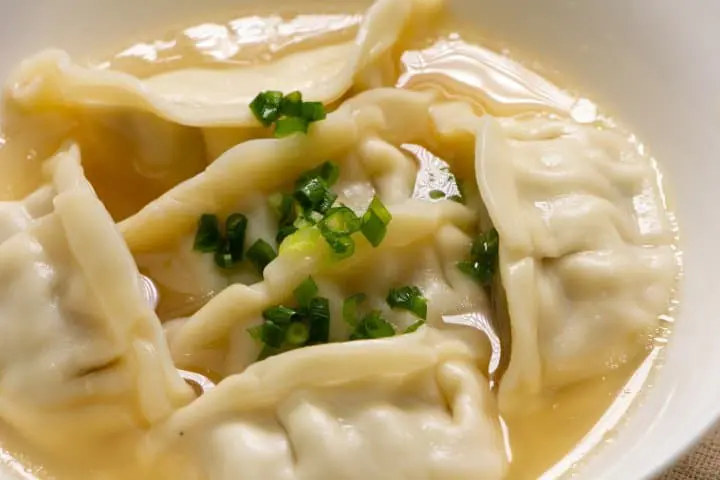
Photo by Pixta
Gyoza are considered a variation of the Chinese "jiaozi" dumpling, which you can distinguish by the heavier use of garlic. When it comes to "potstickers", a popular name for a type of Chinese dumpling, many might have trouble telling the two apart. The store-bought and generic version are said to be the same.
Ready-made, frozen gyoza

Frozen Gyoza Pancakes - a convenient delight found at supermarkets. With 12 pieces per pack, these frozen gems provide a quick and tasty meal when fried for just 5 minutes. The aroma of savory fillings permeates as they sizzle and crisp in the pan, setting the stage for a flavorful experience. Once ready, the golden-brown pancakes reveal a juicy, seasoned interior that tantalizes taste buds. Pair them with soy sauce or a spicy dip for an extra kick. Easy and delicious, these gyoza pancakes offer a hassle-free way to enjoy this Asian classic at home, making every bite a delightful experience.
↑ Return to the top of article.
How To Eat Gyoza
No matter if they're homemade or ordered, no matter if you're eating them as a main dish or alongside ramen as a side dish, gyoza are delicious. So let's talk about how to enjoy yaki gyoza!
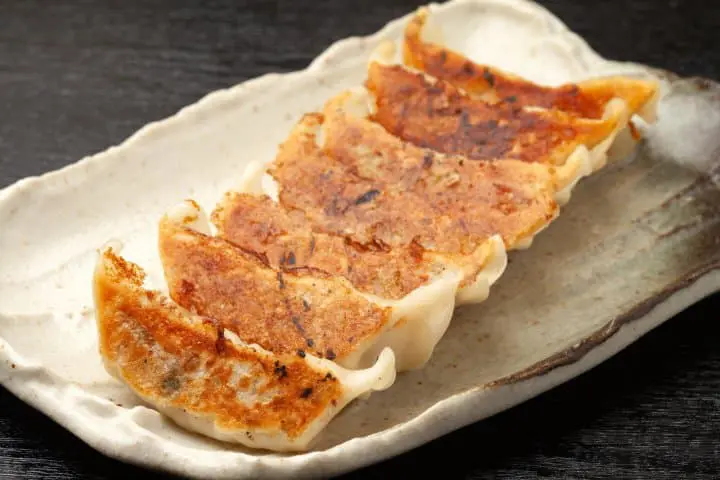
Photo by Pixta
Gyoza at restaurants are often served on a large plate as per-person servings like ichininmae (1 person) and nininmae (2 people). Since the size of each dumpling and total portion depend on the store, it may help to ask what the standard might be when ordering. Also, keep in mind that prices can vary anywhere from 180 to 700 yen, so be sure to check the menu.
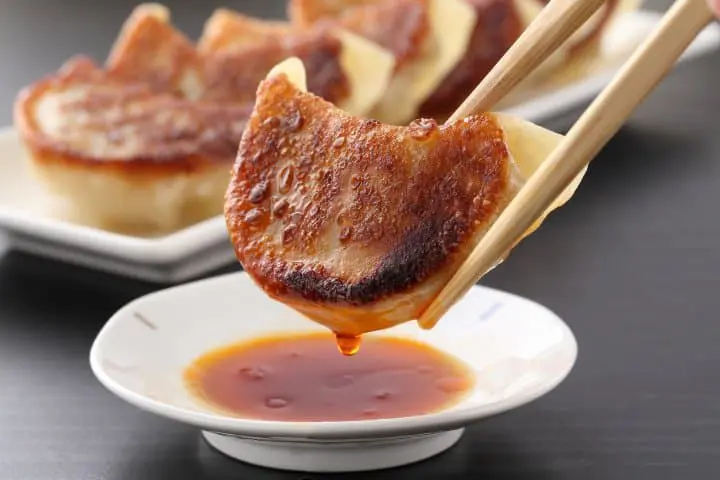
Photo by Pixta
A small dish will come with your large plate of gyoza. This dish is for mixing your sauce. Gyoza is not often heavily seasoned, so this dipping sauce is your way to flavor your gyoza to preference.
On your table, or nearby your counter seat, you will find bottles of vinegar, soy sauce, and raayu (chili oil) (*1). Pour these into the dish provided before you begin eating. The standard ratio for the dipping sauce should be 1:1 of vinegar and soy sauce, but you can adjust to your tastes and even add a few drops of red-colored raayu for some heat.

Photo by Pixta
Now, it's time to dip your freshly grilled gyoza. Take ahold of one morsel up with your chopsticks, and lower it into the sauce. Remember, part of what makes yaki gyoza so delicious is the slightly charred bits, so to not lose out on the wonderful crispy sensation, try to dip only the soft side.
Also, we recommend that you do not cut or separate a single gyoza with your chopsticks before eating. The delicious juices will spill out onto your plate, dampening the experience. Try to eat it in one bite, if you can, or two without lowering it. If it is too hot, let it cool for a minute or two before biting so as not to scorch your tongue!
(*1) Raayu (hili oil) - condiment made by heating spices such as hot chili peppers in vegetable oil.
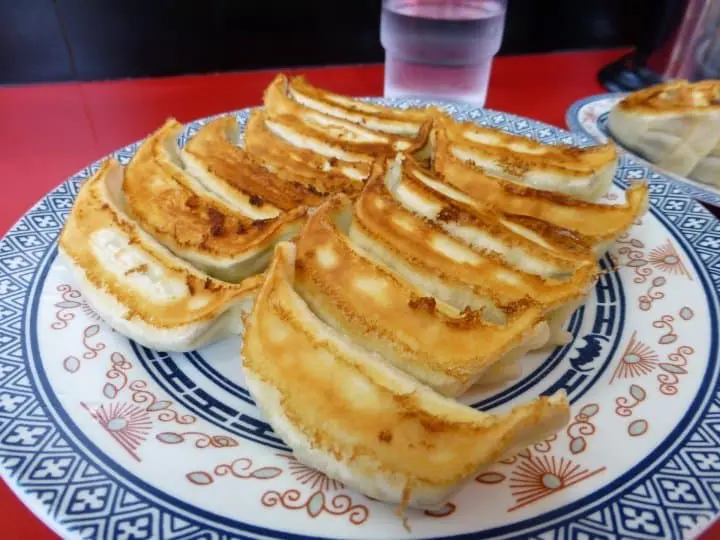
Gyoza, which are packed with lots of garlic and chives and fried to perfection, have long been considered a satisfying food to enjoy over drinks. They can be happily paired with beer, highballs, or sours. Depending on the person, you may even see some opt for wine!
With such a "late night" reputation, gyoza can be quite the guilty pleasure. Recently, however, restaurants have popped up that serve a "healthier" version of gyoza using lots of vegetables as well as garlic that doesn’t smell after eating. Small, easy-to-eat, and reasonably priced, gyoza are now being enjoyed more and more without any guilt involved.
↑ Return to the top of article.
The Two “Gyoza Towns”
Utsunomiya in Tochigi Prefecture and Hamamatsu in Shizuoka Prefecture are known as the “Gyoza Towns”. Many households in both cities are gyoza lovers, with the average household spending over 4,000 yen annually on gyoza. Several hundred gyoza restaurants compete with each other in these prefectures.

Utsunomiya, a gyoza paradise in Japan, boasts top spots like "Niku no Ohyama" and "Gunma Maru" for dumpling aficionados. "Niku no Ohyama" crafts crispy gyoza paired with a special soy sauce, while "Gunma Maru" serves up jumbo, flavor-packed dumplings that redefine gyoza indulgence.

In Hamamatsu, Japan, gyoza enthusiasts flock to "Osuimono" and "Gyoza Shunsai" for a culinary escapade. At "Osuimono," expect a unique twist on gyoza with flavors that captivate the palate. Meanwhile, "Gyoza Shunsai" offers a blend of tradition and creativity, showcasing the city's rich culinary heritage. These establishments epitomize Hamamatsu's commitment to gyoza excellence, where each dumpling tells a tale of passion and expertise.
In addition to yaki gyoza, there are a variety of other gyoza, including sui gyoza with a plump wrapper made by boiling them, age gyoza (fried dumplings) with a crispy wrapper made by frying, and so on. If you happen to be near these towns, do try and taste the different delicious gyoza!
↑ Return to the top of article.
8 Recommended Gyoza Restaurants in Tokyo
1. Gyouzabou chohakkai
This gyoza specialty restaurant is on the fancier side, so a reservation is recommended.
*Reservation Recommended
Address: 3-37-5 Asagayaminami Suginami Tokyo
Hours: 18:00 - 24:00
Closed Days: Mondays (possibly Sundays)
Telephone: 03-3398-5527
2. Gyouza no mise Ranshuu
A shop so delicious and affordable, you'd be lucky to get in without waiting. Each gyoza is made by hand when you order, so its bound to be hot and fresh, and only at 400 yen to 600 yen depending.
While yaki gyoza is a specialty for most restaurants, this shop also offers a sui gyoza dish so delicious it needs no sauce, but you can order a cilantro topping for an extra kick. That does not mean the yaki gyoza here are anything to laugh at. They have one with garlic chive egg filling that will have your mouth watering.
Address: 4-25-1 Tateishi Katsushika Tokyo
Hours: Tuesday-Saturday 18:00-1:00; Sundays and National Holidays 18:00-23:30
Closed Days: Mondays
Telephone: 03-3694-0306
3. Pairon
Order the black, white, red, and blue set! This shop offers gyoza varieties from 100 percent meat fillings to strong chive and garlic mixes that will not disappoint. Set lunches run from 700 to 900 yen, and come with soup and sides.
Address: 8-32 Shinogawamachi Shinjuku Tokyo
Hours: Monday-Saturday, 11:30-14:30 and 17:00-23:00; Sundays and National Holidays, 12:00-14:30 and 17:00-21:00
Closed: Unscheduled closing occur, please call ahead
Telephone: 03-3260-6571
4. Okei
The shop masters here leave nothing to chance with their gyoza. They really lock in the flavor with their frying methods, presenting a row of gyoza beautifully browned and prepped for that first bite. With wonderfully balanced meat and vegetable inner mix, this shop's affordable yaki gyoza is sure to please.
Address: 2-12-16 Fujimi Chiyoda Tokyo
Hours: 11:30-13:50; 17:00-20:50
Closed: Sundays, National Holidays, 3rd Monday of the Month
Telephone: 03-3261-3930
5. Azumatei
This shop may only be open 2 hours in the evening, but with most meals under 1,000, it is definitely an experience worth having. A home-style feel, the yaki gyoza here are served up a bit larger, with a properly crisp outer edge. The garlic and chives flavor will leave quite the impression, so why not stop by for a bite?
Address: 2-50-13 Higashiikebukuro Toshima Tokyo
Hours: 17:00-19:00 (Take-Out)
Closed: Wednesdays, Saturdays, Sundays, National Holidays
Telephone: 03-3985-5659
6. Utsunomiya Gyoza Kaikan in Asakusa
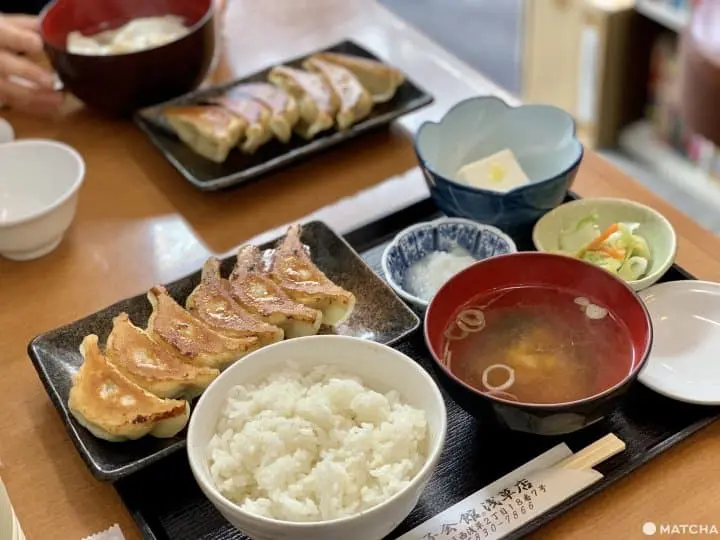
Utsunomiya, renowned for its gyoza tradition, owes its dumpling fame to wartime encounters when Japanese troops stationed in Manchuria brought back this culinary gem. Nestled in Tochigi Prefecture, Utsunomiya benefits from the region's chive abundance, a crucial gyoza ingredient. Consequently, residents have embraced dumplings as a beloved home-cooked staple.
Gyoza Kaikan, a branch in Asakusa, echoes Utsunomiya's culinary prowess, serving chewy-skinned dumplings bursting with vegetable goodness and a tantalizing sweet essence. Their set meal, a steal at 660 yen, offers miso soup, appetizers, cold tofu, and rice, delivering a hearty and flavorsome dining experience.
7. Dekkai Gyoza Sosan no Mise in Yoyogi
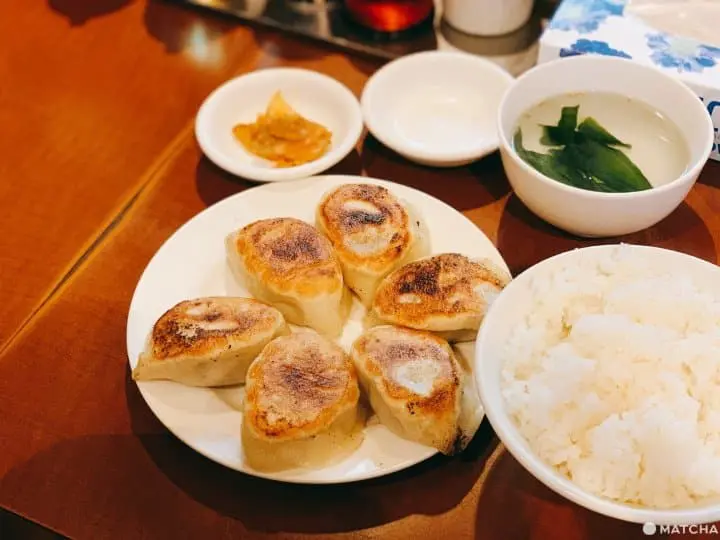
At Sosan no Mise, weekdays see the first-floor bustling with patrons eager for their oversized and juicy gyoza dumplings. The unique selling point? Their substantial size and flavorful fillings. Inside, a sign warns diners of the potential for these dumplings to burst with savory juices, urging caution.
Each bite reveals a thick, chewy skin harmonizing with the blend of ginger, chives, scallions, and onions, striking a perfect sweet-savory balance that satisfies without needing additional condiments. For an extra treat, pouring the luscious meat juices over a bowl of rice elevates the experience. Don't miss the gyoza set meal at 650 yen for a delightful treat!
8.Meat Gyoza Dandadan
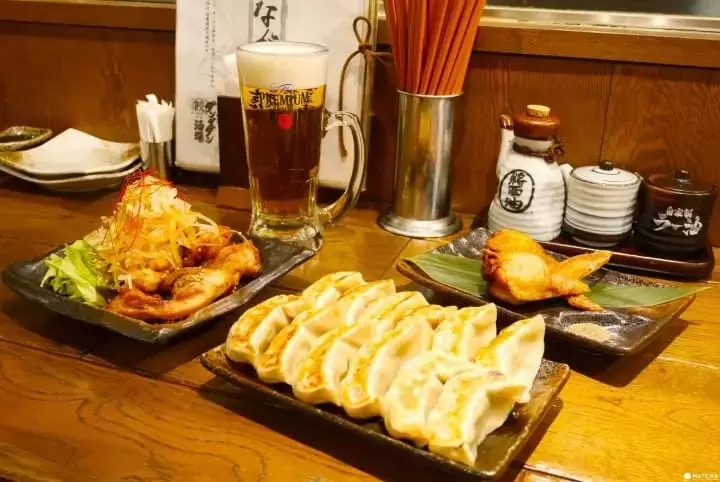
Dandadan, or Nikujiru Gyoza Dandadan, is a renowned izakaya bar in Tokyo that specializes in gyoza dumplings and fried chicken. Unlike traditional gyoza served as a side dish, Dandadan offers gyoza as a main course alongside drinks.
With over 50 locations in Tokyo and Kanagawa, the chain's signature dish, the Original Juicy Fried Gyoza (440 yen/person), steals the spotlight. Featuring whole wheat flour skins and premium pork fillings, each bite releases a flavorful broth that perfectly complements the pork's sweetness. Additionally, their gyoza chicken wings (470 yen) and Chinese-style fried chicken (690 yen) coated in a unique sauce offer refreshing complements to your dining experience.
↑ Return to the top of article.
Easy To Make at Home! How To Make Gyoza
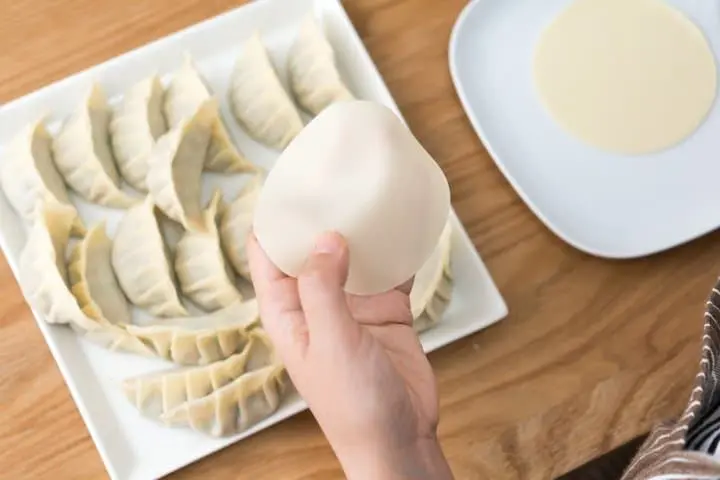
Photo by Pixta
Most supermarkets sell various kinds of gyoza wrappers, and every family has their own take on what to put in them, how to wrap them, and how best to cook them. For many Japanese, gyoza represents the taste of home-cooked meals, while many younger people like to whip up gyoza to go with curry rice, ramen, or fried chicken.
Would you like to try making gyoza at home? It's easy, fun, and you can definitely get creative with this popular Japanese dish. Let us walk you through a basic yaki gyoza recipe.
Basic Gyoza Ingredients
Vegetables
2 cups chopped cabbage
1/4 cup chopped Asian chives or scallions
1/4 cup chopped carrot (optional)
Wrappers
1 (10 ounce) package wonton wrappers (any store brand will work)
Meat
1/2 pound ground pork (or any ground meat)
Seasoning/oil
1 tablespoon sesame oil
1 tablespoon soy sauce
1~2 clove garlic, chopped
3 cm ginger peeled, grated/finely chopped
chili oil (optional)
As you can see, one of the keys to good gyoza lies in its seasonings.
Cooking Directions
For cooking gyoza, you'll need a bit of space to use as your work station. We recommend gathering with family or friends at a table for an enjoyable creation process.ss
Inner Mix
Wash and cut your vegetables to an appropriate size. Room temperature cabbage is softer, so allow the cabbage to sit out for a while or run it under warm water. Also, when it comes to cutting, remember that this will be placed inside small wanton wrappers, so keep pieces nice and small so you don't wind up with a gyoza is one big piece of cabbage! Chop up your garlic and ginger as well.
There is a bit of a split on whether to cook the ground meat at this stage, before creating the inner mix. If you prefer to cook the meat first, coat a large skillet with the sesame oil, mix the meat with the garlic and ginger, and cook the meat on medium, high heat until an even brown. Or, you can skip this step do all the cooking together once in the wrappers.
Put together your inner mix by combining the cabbage, scallions, garlic, ginger, and carrot, and ground pork. Mix these with the soy sauce and sesame oil, and let sit for a few minutes to marinate.
Make the Gyoza
Prepare some empty plates or platters along with a cup of warm water for this stage.
Get out the wrappers and place approximately 1 tablespoon of the cabbage and pork mixture in the center of each wrapper. Wet your fingers in the cup, dab the edges of the wrapper, and then fold the wrapper in half overfilling. The wet edge should act as a glue. Seal the edges with moistened fingers, pinching in your own wavy look. Line the uncooked gyoza on the platters to be cooked.
Let's Cook!
In preheated vegetable oil (about 1 tablespoon should be enough), line the gyoza up in a skillet to cook for about 1-2 minutes over medium-high heat. Once the edges are brown, add about a 1/2 cup of water, cover with a lid, and allow the gyoza to cook through half-submerged. This takes about 4 or 5 minutes depending. If the water evaporates, add more. Move the cooked gyoza back to the platters to cool slightly, and repeat this cooking process until all gyoza are done.
Serve these warm, bite-sized delectables with a side of soy sauce and rice vinegar sauce for ultimate enjoyment!
↑ Return to the top of article.
FAQ
How are you supposed to eat gyoza?
To savor gyoza, pick up a dumpling with chopsticks or fingers, dip it in a soy-vinegar sauce, and take a cautious bite to relish the mix of flavors: the savory filling and the crispy exterior. Be mindful of the hot filling! Appreciate the textures and tastes as you enjoy each dumpling, optionally adding ginger or garlic for extra zest. Repeat the process, experiencing the blend of juicy fillings and dipping sauce until you've relished every delightful gyoza dumpling.
What do Japanese people eat with gyoza?
Japanese people often pair gyoza with a variety of accompaniments to enhance their dining experience. Common choices include steamed white rice for a simple meal, miso soup to add warmth, and pickled vegetables or salads for contrasting flavors. Gyoza also pairs well with hearty dishes like ramen or traditional beverages such as Japanese beer or sake, enriching the overall taste. Additionally, green tea serves as a popular refreshment option to cleanse the palate between bites of the savory dumplings. These combinations create a harmonious blend of flavors and textures, offering a delightful and fulfilling dining experience alongside gyoza.
How is gyoza traditionally served?
Traditionally, gyoza is served as a side dish or appetizer in Japanese cuisine. The dumplings are typically pan-fried on one side until crispy and golden brown, creating a contrast between the crunchy bottom and the tender filling inside. Gyoza is usually arranged neatly on a plate or serving dish, often in a circular or linear pattern. It is commonly accompanied by a dipping sauce made of soy sauce, vinegar, and sometimes chili oil or other condiments to add flavor. Garnishes like sliced green onions or sesame seeds may be sprinkled on top for an added touch of presentation and taste. The communal aspect of sharing gyoza with friends or family adds to the traditional dining experience, making it a social and enjoyable meal.
Is gyoza from Japan?
While the origins of gyoza can be traced back to China, these beloved dumplings have been embraced and adapted in Japan to become a significant part of Japanese cuisine. In Japan, gyoza has evolved to have its own unique characteristics, such as thinner skins, different fillings, and various cooking methods like pan-frying or boiling. The Japanese version of gyoza often features a blend of pork, cabbage, garlic, ginger, and other seasonings, distinct from the original Chinese varieties. Today, gyoza is widely enjoyed throughout Japan and has become a staple dish in Japanese restaurants and households, showcasing the country's love for this flavorful and versatile dumpling dish.
What is Japan's number 1 gyoza?
Japan has a strong affection for gyoza, and while preferences can vary from person to person, one of the most renowned and celebrated gyoza establishments in Japan is "Honzarashi Gyoza Osho" (本枕餃子 おしょう). Honzarashi Gyoza Osho is a popular chain of gyoza restaurants known for its delicious and high-quality dumplings. Their gyoza is famous for its flavorful fillings, crispy skins, and overall excellent taste, making it a top choice for many gyoza enthusiasts in Japan. While tastes are subjective, Honzarashi Gyoza Osho is frequently cited as one of Japan's best gyoza spots by locals and visitors alike.
What is a gyoza made of?
Gyoza, a beloved Japanese dumpling dish, is crafted from a delicate dance of ingredients. Its construction involves a thin dough wrapper made of flour and water, enveloping a savory filling comprising ground meat (like pork or chicken), finely chopped vegetables (such as cabbage, garlic, ginger, and green onions), and an array of seasonings like soy sauce, sesame oil, and spices for depth of flavor. Once prepared, these dumplings are typically pan-fried to achieve a crispy bottom, then steamed or boiled to ensure the wrapper and filling are cooked to perfection. Served with a dipping sauce melding soy sauce, vinegar, and chili oil, gyoza represents a harmonious blend of textures and tastes that captivate the palate in every delightful bite.
Enjoy the Delicious Japanese Gyoza!
We hoped we piqued your interest in tasting and cooking gyoza, a delicious dish loved by everyone in Japan!
↑ Return to the top of article.
This is the official account of MATCHA's editorial department. Our articles feature useful travel information for visitors to Japan, from how-to guides to recommended places to visit.






































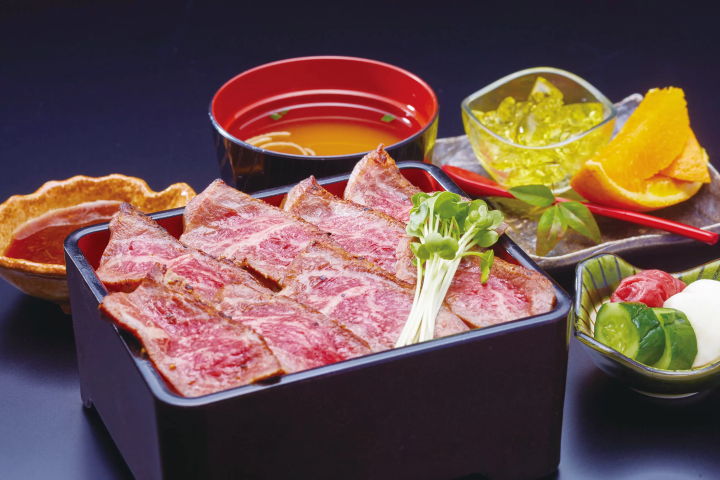

![[2026] Family Winter Trip to Suzuka Circuit! – For Both Day trips and Overnight Stays!](https://resources.matcha-jp.com/resize/720x2000/2025/12/26-254097.webp)

![[2026 Latest] "Harukas 300 (Observation Deck)" "Abeno Harukas Kintetsu Main Store"](https://resources.matcha-jp.com/resize/720x2000/2025/04/03-230066.webp)